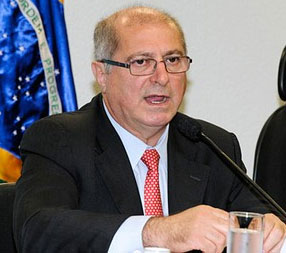The Brazilian government will continue to require that a significant portion of telecoms network equipment is manufactured locally as it seeks to harness the sector's growth to create jobs and local wealth, according to the country's minister for communications.
November 22, 2012

The Brazilian government will continue to require that a significant portion of telecoms network equipment is manufactured locally as it seeks to harness the sector’s growth to create jobs and local wealth, according to the country’s minister for communications.
Speaking at the Ericsson Business Innovation Forum in Sao Paulo on Wednesday, Paulo Bernardo said that targets for wider deployment of broadband require sustained investment from both public and private sectors. As an example he pointed to more than 80,000 rural schools that must be given connectivity inside the next three years.
He said that, in Brazil, the state is responsible for over 50 per cent of investment in innovation and was committed to creating the right environment for continued private sector participation. In return, he said, the government expects technology developed locally to be available at a low enough cost to make connectivity across some of the most challenging geography in the world truly viable.
“The treasury has been removing taxes from equipment and civil construction works because to reach our objectives, and our national broadband plan next year, we need infrastructure available at fair prices,” he said. “We have policies that will demand products made in Brazil because it helps create jobs and trade. In my opinion this is a policy that is here to stay; it is reasonable for companies to invest to develop here in Brazil.”
Sergio Quiroga da Cunha, Ericsson’s head of Latin America said that Brazil’s original suggestion that all LTE technology deployed in the country be locally produced simply wasn’t possible. While the vendor does manufacture equipment and conduct R&D locally, and is the only large network vendor to do so in its own factories, he said, many components have to be imported. Instead the firm gets tax breaks for guaranteeing that its products contain up to ten per cent of locally produced hardware, he said.
But investment alone cannot guarantee that Brazil’s targets will be hit. Quiroga da Cunha said that a fund for the universalisation of telecoms in Brazil, created by collecting 0.4 per cent of operator revenues since currently sits at almost $5bn but is not being tapped because “nobody is sure how to use it”.
One thing is clear, he said: greater density of mobile networks is essential in Brazil. Currently there are only 60,000 cell sites in the country and, while much of Brazil is sparsely populated or uninhabited, this number needs to more or less doubled before the kind of coverage and capacity that the market requires is available.
One problem, he said, is that “site acquisition is a nightmare. 99 per cent of the time you can be guaranteed a refusal for planning applications for a new site.” It was a point echoed by Minister Bernardo, who said he was constantly battling with regional and municipal governments whose planning legislation made it impossible to expand and densify the network. “We have many cities where they say we cannot have antennas near schools. But how can I connect a school if not with an antenna nearby? We need to change this, the law has to help us.”
The LTE Latin America conference is taking place on the 13th-14th May 2013 at the JW Marriott Marquis, Dubai. Click here to pre-register for the event.
About the Author(s)
You May Also Like








.png?width=300&auto=webp&quality=80&disable=upscale)


_1.jpg?width=300&auto=webp&quality=80&disable=upscale)


.png?width=800&auto=webp&quality=80&disable=upscale)